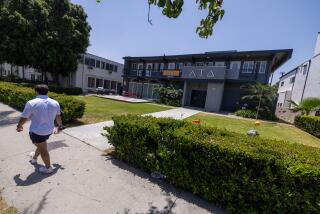UC Professor, ’82 Unabomb Victim, Dies
- Share via
BERKELEY — Diogenes Angelakos, a UC Berkeley electrical engineer who was one of the Unabomber’s first victims, has died of prostate cancer, the school said Tuesday. He was 77.
Angelakos, who died Saturday at his Berkeley home, had battled the disease for more than six years.
The scientist was serving as director of the Electronics Research Laboratory at UC Berkeley on July 2, 1982, when he grabbed the handle of a booby-trapped package in a coffee room.
The pipe bomb exploded, mangling his right hand. He avoided more serious injury when a gasoline can attached to the bomb failed to explode. After extensive surgery, he eventually learned to write again, but retained powder burns as a permanent reminder of the bombing.
Three years later, Angelakos was the first to offer aid to a second Berkeley victim of the Unabomber, John Hauser, a graduate student who had hoped to become an astronaut. Angelakos used a tie to fashion a tourniquet for Hauser’s arm, which was permanently maimed in the May 15, 1985 bombing. Hauser has never flown in space.
Both bombs exploded in Berkeley’s computer sciences facility known as the Cory Building. The devices did not appear to be aimed at specific victims.
In 1994, Angelakos said he had put his attack behind him.
“You get hit by a car, and you are very careful about crossing the street for a while. Then you’re back to where you are,” he said. “You don’t go around shaking every time you get a letter.”
After the arrest of Theodore Kaczynski--who had worked at Berkeley as a math professor--on suspicion of the Unabomber attacks, Angelakos said he didn’t understand the motivation.
“I would like to ask the guy . . . if he believes in making changes for the good, why would he be hurting people? That’s the only thing I’d like to know,” Angelakos said.
His fellow professors said Angelakos should be remembered for his accomplishments as a professor and director of the laboratory for 20 years, not his status as a victim.
Angelakos was a pioneer in the field of microwaves, antennas and electromagnetic waves, and was a student advocate, faculty members said.
“He was very much a people person, encouraging faculty and students to interact with one another,” said Andrew Neureuther, whom Angelakos enticed to Berkeley as an electronic engineering professor in 1966. “He was always a proponent of the students.”
Angelakos was born in Chicago in 1919 and received his degrees from Notre Dame and Harvard universities. He worked briefly at Notre Dame before going to Berkeley in 1951 and becoming director of the lab in 1964.
He retired as director in 1984, but continued to work with the lab, receiving the school’s highest faculty award, the Berkeley Citation.
His wife, Helen, died of cancer in 1982, and his son, Demetri, of sickle cell anemia and thalassemia in 1979. He is survived by a daughter, Erica Angelakos of Seattle.
The university plans a memorial for Angelakos in the fall.
More to Read
Sign up for Essential California
The most important California stories and recommendations in your inbox every morning.
You may occasionally receive promotional content from the Los Angeles Times.













